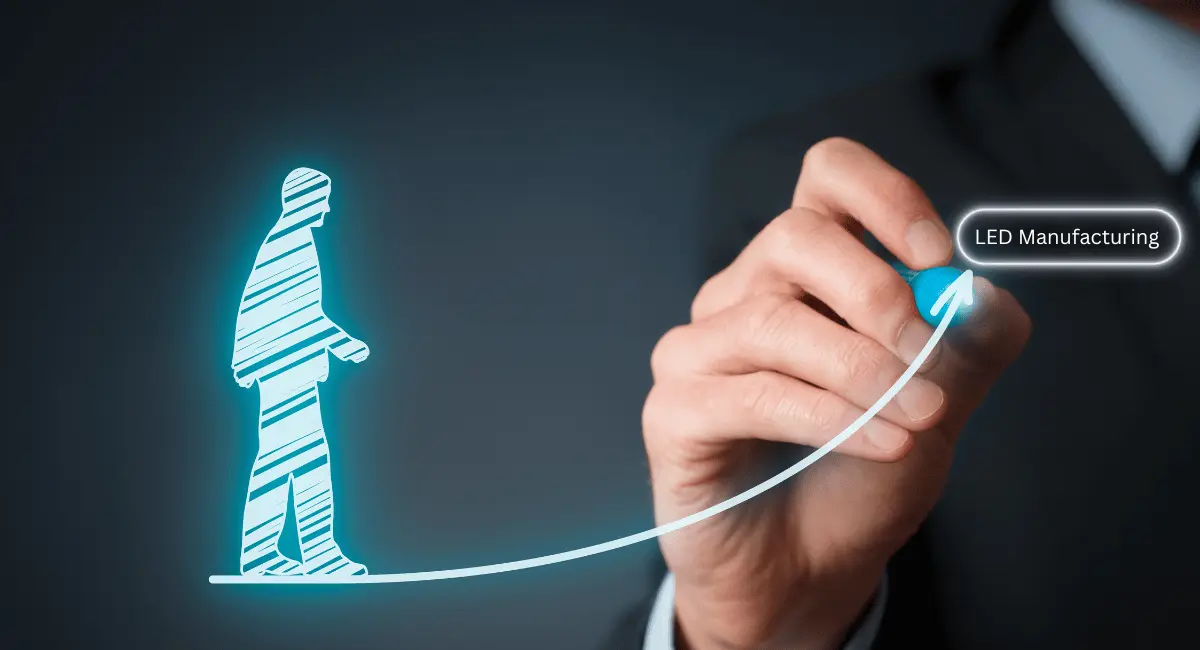


The journey of LED manufacturing in India has been marked through tremendous traits, pushed via each technological improvements and authorities initiatives.
Major technological advances have characterized the history of LED lights (light-emitting diodes) that span several decades. Below is a summary of key milestones. Below is a summary of key milestones.
1. Early discoveries (1907-1950s)
In 1907, British inventor H.J. first rounded the luminescence of carborundum crystals (compounds). Additionally, made of silicon and carbon, this represents an early discovery of electroluminescence(Light-emitting capacitor - LEC).
Furthermore, Russian scientist Oleg Losev (Russian scientist and inventor) independently reported the phenomenon of electroluminescence (Light-emitting capacitor - LEC) in the 1920s.
2. Invention of the LED (1962)
The realistic software of LEDs commenced with the discovery of the primary sensible visible-spectrum LED by way of Nick Holonyak Jr., a researcher at General Electric, in 1962. Additionally, he used gallium arsenide phosphide (GaAsP), a semiconductor material used in optoelectronics, including LEDs and photodiodes, to create a crimson LED.
3. Development of Other Colors (1970s-1980s)
In the subsequent years, researchers made considerable strides in developing LEDs that emitted other colors. Additionally, Shuji Nakamura, a Japanese scientist, created the primary blue LED in 1994. This was an essential step forward because it allowed for the creation of white light when mixed with pink and green LEDs.
4. Commercialization and Popularization (1990s-2000s)
During the 1990s, LED lighting began to be widely commercialized for various uses, expanding beyond just indicator lights and traffic signals. Additionally, this shift was driven by ongoing improvements in LED performance and brightness, making them increasingly viable for general lighting purposes. Furthermore, advancements in manufacturing techniques and materials, particularly the use of gallium nitride, played a crucial role in the development of high-brightness LEDs.
5. Widespread Adoption (2010s-2020s)
The LED era has become broadly adopted for widespread lights due to its strength efficiency, lengthy lifespan, and environmental blessings. Furthermore, Governments worldwide promoted the usage of LED lighting to reduce power consumption, leading to the phasing out of conventional incandescent bulbs in many regions. Continued research and development targeted enhancing the color rendering index, performance, and value-effectiveness of LEDs.
6. Smart and Connected Lighting (2010s)
The integration of LED technology with clever controls and connectivity has grown to be a great fashion. Additionally, this includes the improvement of clever LED bulbs, furniture, and systems that can be managed remotely through smartphones or different gadgets
7. Ongoing Innovations (2020s and Beyond)
Ongoing research and development efforts purpose to further enhance the performance and performance of LEDs. In addition, the exploration of recent substances, such as quantum dots, holds promise for future advancements in LED generation. The history of LED lights is a testimony to the continuous innovation and development in lighting fixtures era, main to the sizable adoption of LEDs for diverse programs in the modern-day global.
The journey of LED manufacturing in India has been marked by tremendous traits, pushed via technological improvements and authorities initiatives. Here's an outline of the important thing stages in the evolution of LED manufacturing in India
1. Introduction and Early Adoption (2000s)
Additionally, LED technology gained attention in India within the early 2000s as a promising answer for power-green lights. Furthermore, initial adoption becomes mainly in niche programs, including visitor alerts and electronic presentations.
2. Government Initiatives (2010s)
The Indian government recognized the ability of LED technology for electricity financial savings and environmental sustainability. Additionally, in 2010, the Bureau of Energy Efficiency (BEE) launched the Bachat Lamp Yojana (BLY) program, promoting the usage of energy-efficient LED bulbs by providing subsidies to clients. The Domestic Efficient Lighting Programme (DELP) was released in 2015. Furthermore, it aimed at encouraging the adoption of LED bulbs in households.
3. Rise of Domestic Manufacturing (2010s)
To promote self-reliance and enhance the manufacturing region, the government added the "Make in India" initiative in 2014. LED producers started organizing production facilities in India, contributing to the increase of the home LED manufacturing industry.
4. Mass Production and Cost Reduction (2010s)
As the demand for LED lighting fixtures increased, manufacturers scaled up production to acquire economies of scale, leading to a reduction in the cost of LED products. Furthermore, many Indian companies began manufacturing LED components and assembling LED lighting domestically.
5. Quality Standards and Certifications
Additionally, in order to ensure the first-class and reliability of LED merchandise, the Bureau of Indian Standards (BIS) introduced requirements and certifications for LED lights products. Moreover, compliance with these requirements became essential for producers to gain consumer trust and compete effectively in the market.
6. Government Procurement Programs (2010s)
Furthermore, the UJALA scheme not only increased the availability of LED bulbs but also raised awareness about the benefits of using energy-efficient lighting. As a result, there was a significant shift in consumer preferences towards LED products, leading to an increase in the production of LED bulbs and related merchandise. This indicates that the government's efforts to promote LED adoption have had a positive impact on the market, contributing to the growth of the LED industry in India.
7. Technological Advancements (2010s-Present)
Continuous studies and improvement efforts have targeted on improving the efficiency, lifespan, and performance of LED products. Indian producers have been making an investment in superior technology to live aggressively and meet the evolving demands of the market.
8. Export Opportunities (Present)
With the increase of the home LED market, a few Indian LED manufacturers have expanded their attain to international markets, exporting LED merchandise to numerous international locations. The journey of LED manufacturing in India reflects a dynamic landscape, with a gradual shift from import-dependent markets to a self-enough industry. Government projects, blended with advancements in technology and a focus on high quality, have played a crucial function in shaping the LED production zone within the country.
The Usage of led (Light Emitting Diode) lighting gives an extensive variety of benefits across numerous components, contributing to its tremendous adoption. Here are a few key benefits of the usage of LED lights
1. Energy Efficiency
LED lighting fixtures are noticeably energy-efficient, changing an enormous element of electrical power into visible light. This results in lower energy intake in comparison to standard incandescent and fluorescent lights.
2. Long Lifespan
LEDs have a really lengthy lifespan, regularly lasting tens of thousands of hours. This longevity reduces the frequency of replacements, main to price savings in phrases of maintenance and alternative prices.
3. Durability and Resilience
LED lighting is a solid-kingdom lighting fixture gadget, making them more durable and proof against shocks, vibrations, and outside impacts in comparison to fragile bulbs like incandescent or fluorescent lights.
4. Instantaneous Lighting
Additionally, LED lights remove darkness immediately when powered on, without the warm-up time required by using some other sorts of lights. This feature is particularly tremendous in applications wherein instantaneous, full brightness is wanted.
5. Directional Lighting
LEDs emit light in a particular direction, supplying extra targeted illumination. This directional function makes them ideal for numerous applications, inclusive of undertaking lighting and accent lights, reducing wasted light and energy.
6. Color Range and Flexibility
LEDs are available in an extensive variety of colors without the want for filters. Additionally, they may be effortlessly dimmed or adjusted, providing flexibility in growing dynamic and Customizable lighting environments. Furthermore, they are energy-efficient and long-lasting, making them a cost-effective choice for lighting solutions.
7. Environmentally Friendly
Additionally, LED lighting fixtures are more energy efficient than fluorescent lighting, which means they can help reduce electricity usage and lower energy bills. In addition, they have a longer lifespan, reducing the frequency of replacements and therefore reducing waste. Furthermore, LEDs provide better quality light and can be easily dimmed, offering more control over the lighting environment.
8. Low UV Emissions
LEDs emit very little ultraviolet (UV) radiation, reducing the ability for harm to touchy materials and minimizing the appeal of bugs to the mild supply
9. Cost Savings
Additionally, LED lights are known for their energy efficiency. Consequently, they are often considered an environmentally friendly option. In contrast, traditional incandescent bulbs consume more energy and have a shorter lifespan, resulting in higher long-term costs. Therefore, it is evident that LED lights are a more practical choice for those looking to save money and reduce their environmental impact.
10. Smart Lighting Integration
LED era without problems integrates with clever light structures, allowing customers to control brightness, color, and scheduling remotely. This complements energy management and presents delivered convenience and capability.
11. Reduced Carbon Footprint
Additionally, the long lifespan of LED lighting fixtures reduces the need for frequent replacements, ultimately decreasing waste and resource consumption. Moreover, the energy efficiency of LED lighting fixtures results in lower electricity usage and cost savings. As a result, LED lighting fixtures are a sustainable and environmentally friendly option for lighting needs.
12. Improvement in Safety
Additionally, LEDs emit little warmth, decreasing the chance of burns or fires. Consequently, this makes them more secure for use in diverse programs, such as in homes, places of work, and public spaces. Moreover, the numerous advantages associated with LED utilization have placed them as the preferred light technology in a wide variety of applications, from residential lighting to commercial and industrial settings. Furthermore, the ongoing advancements in the LED era help to enhance these benefits and expand the scope of LED applications.
Conclusion
In the vibrant tapestry of India's industrial landscape, the journey of LED manufacturing has been nothing short of illuminating. From humble beginnings to becoming a powerhouse in the global market, this sector has seen remarkable growth, driven by innovation, sustainability, and a commitment to quality.
Sign Up Our Newsletter And Get Latest Updates